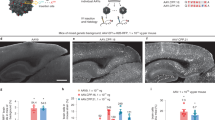Abstract
The clinical use of retroviral vector producer cells (VPCs) to deliver retroviral vectors efficiently to target cells has been investigated as a method to increase efficiency of gene delivery, presumably as a result of continued vector production in vivo. Studies were conducted in rats to evaluate the distribution of vector to distal organs and tissues as measured by transduction. Rats were treated with two doses of VPCs using two routes of administration: (1) subcutaneous injection, chosen to maximize both the dose and exposure of animals, thereby enabling identification of potential target organs under worst-case conditions; and (2) direct injection into brain parenchyma, chosen to mimic the intended clinical route of administration and provide an estimate of risk to patients receiving this therapy. Twelve organs or tissues were collected 7 days after administration of VPCs and analyzed by PCR for the presence of vector and vector producer cell sequences. Vector was detected most frequently at the site of injection by either route of administration. Less frequently, vector was detected in draining lymph nodes at the higher dose only using either route of injection. Single specimens of lung and contralateral skin were positive for vector following subcutaneous administration only. Vector was detected in gonadal tissue from a single low-dose male following subcutaneous administration, but this finding was not reproduced in any high-dose male or any males injected intracerebrally. In contrast, VPCs were detected only at the site of administration. The frequency of detection of VPCs 7 days after administration was higher when rats were injected by the intracerebral route. Based on these studies, gene transfer to distal organs or gonadal tissue following intracerebral administration of VPCs is not considered to be a risk to patients undergoing retroviral vector gene therapy for the treatment of brain cancer (glioblastoma multiforme; GBM).
This is a preview of subscription content, access via your institution
Access options
Subscribe to this journal
Receive 12 print issues and online access
$259.00 per year
only $21.58 per issue
Buy this article
- Purchase on Springer Link
- Instant access to full article PDF
Prices may be subject to local taxes which are calculated during checkout

Similar content being viewed by others
References
Moolten FL . Tumor chemosensitivity conferred by inserted thymidine kinase genes: paradigm for a prospective cancer control strategy Cancer Res 1986 46: 5276–5281
Ezzeddine ZD et al. Selective killing of glioma cells in culture and in vivo following retrovirus transfer of the herpes simplex virus thymidine kinase gene New Biologist 1991 3: 1–7
Miller AD, Rossman G . Improved retroviral vectors for gene transfer and expression BioTechniques 1989 7: 980–990
Brown PO . Integration. In: JM Coffin, SH Hughes, HE Varmus (eds) Retroviruses Cold Spring Harbor Laboratory Press: NY 1997 pp 161–203
Luciev PA, Leung NJ . Mechanisms of retrovirus replication. In: Levy JA (ed) The Retroviridae (Viruses) vol. 1: Plenum Press: New York 1992 pp 159–298
Short MP et al. Gene delivery to glioma cells in rat brain by grafting of a retrovirus packaging cell line J Neurosci Res 1990 27: 427–439
Ram Z et al. Therapy of malignant brain tumors by intratumoral implantation of retroviral vector-producing cells Nature Med 1997 3: 1354–1361
Long Z et al. Biosafety monitoring of patients receiving intracerebral injections of murine retroviral vector producer cells Hum Gene Ther 1998 9: 1165–1172
Long Z et al. Molecular evaluation of biopsy and autopsy specimens from patients receiving in vivo retroviral gene therapy Hum Gene Ther 1999 10: 733–740
Cosset F-L et al. High titer packaging cells producing recombinant retroviruses resistant to human serum J Virol 1995 69: 7430–7436
Rother RP et al. A novel mechanism of retrovirus inactivation in human serum mediated by anti α-galactosyl natural antibody J Exp Med 1995 182: 1345–1355
Rother RP, Squinto SP . The α-galactosyl epitope: a sugar coating that makes viruses and cells unpalatable Cell 1996 86: 185–188
Lyons RM et al. An improved vector encoding the Herpes simplex virus thymidine kinase gene increases antitumor efficacy in vivo Cancer Gene Ther 1995 2: 273–280
Finsen BR et al. Leukocyte infiltration and glial reactions in xenografts of mouse brain tissue undergoing rejection in the adult rat brain: a light and electron microscopical immunocytochemical study J Neuroimmunol 1991 32: 159–183
Kamantigue E et al. Evidence for localization of biologically active recombinant retroviral vector to lymph nodes in mice injected intramuscularly Gene Therapy 1996 3: 128–136
Kotani H, McGarrity GJ . Safe, efficient production of retroviral vectors. In: Oxender DL, Post LE (eds) Handbook of Experimental Pharmacology, vol. 137 Springer-Verlag: New York 1999
Culver KW et al. In vivo gene transfer with retroviral-producer cells for treatment of experimental brain tumors Science 1992 256: 1550–1552
Derelanko MJ . Risk assessment: comparative mammalian organ weights. In: Derelanko MS, Hollinger MA (eds) CRC Handbook of Toxicology CRC Press: New York 1995 p 645
Waynforth HB, Flecknell PA . Intracerebral injections In: Experimental and Surgical Techniques in the Rat 2nd edn: Academic Press: San Diego 1992 pp 39–42
Miller AD, Buttimore C . Redesign of retrovirus packaging cell lines to avoid recombination leading to helper virus production Mol Cell Biol 1986 6: 2895–2902
Acknowledgements
The authors wish to thank HE Black and A Cordier for their contributions in the design and interpretation of toxicological studies, and S Powell and K Stambaugh for critical review of this manuscript.
Author information
Authors and Affiliations
Rights and permissions
About this article
Cite this article
Kaloss, M., Linscott, M., Wey, C. et al. Distribution of retroviral vectors and vector producer cells using two routes of administration in rats. Gene Ther 6, 1389–1396 (1999). https://doi.org/10.1038/sj.gt.3300983
Received:
Accepted:
Published:
Issue Date:
DOI: https://doi.org/10.1038/sj.gt.3300983
Keywords
This article is cited by
-
Selective killing of cancer cells based on translational control of a suicide gene
Cancer Gene Therapy (2002)



